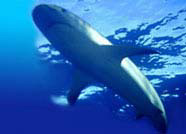


Shark Behavior

 |
 |
 |
|||
| Home | Evolution
| Classification
| Glossary | Biology
| Behavior | Shark
Repellent | Shark
Conservation | Do's &
Don'ts | Did You Know?
Shark Behavior |
 |
||||
|
Senses Unlimited
A shark is equipped with an extraordinary array of senses and has the quality that no other fish or living being under water has. Which is what perhaps makes it the most fearsome predator. Low-frequency sounds tend to travel great distances underwater, so a shark's auditory system could be the first sense to pick up an interesting target. Rapid, irregularly-pulsed, broad-band sounds at frequencies below 600 hertz, similar to those made by injured prey or a group of spawning fish can alert a hunter such as a bull shark from over 1.6 km (1 mile) away. At a distance of 0.5 km (1/3 mile), it is able to smell blood in the water and follow a trail back to the source. It can detect one part of fish extract in 25 million parts of seawater, the equivalent of ten drops of blood in an average-sized municipal swimming pool. At 100 m (330 ft), the shark's lateral line system kicks in. This row of fluid-filled sensory canals on either side of its body responds to pressure changes and movements, so a shark can almost feel the presence and location of something moving in the water--a kind of ' touch-at-a-distance.' At 25m (82 ft) in relatively clear water, the shark can spot movements. It can see even in very dim light, for sharks, like domestic cats, have a tapetum lucidum, a layer of shiny plates behind the retina at the back of the eye that reflects light back onto the retina's light sensitive cells. It ensures that the maximum amount of available light falls on the retina, enabling the animal to see almost in the dark. In sharks, the tapetum can be masked. A curtain of melanin-filled cells, known as melanoblasts, migrates into channels that cover the reflective plates. Using this, a shark is able to rise rapidly from the dimly-lit depths into the bright light of surface waters without being blinded. Not all sharks have the screening--deep-sea sharks have a tapetum but no melanoblasts, an adaptation to a world of inky darkness where the only light is often from bioluminescent fish and other marine creatures. The most extraordinary sensory system is one that discerns electricity. In the snouts of most sharks are small, jelly-filled pits, known as the ampullae of Lorenzini, and in each pit is a sensor that detects minute electric fields associated with contracting muscles, such as those in a pumping heart. The system is remarkably sensitive. A shark is able to detect a change in intensity of a hundred-millionth of a volt per centimeter, the equivalent of a flashlight battery creating a field between two electrodes set 1600 km (1000 miles) apart. In this way, a shark is able to detect muscular activities in its prey, even if the target is hiding under the sand or gravel of the sea bed.  Hammerhead
Sharks of the genus Sphyrna have their electrical sensors spread across
the width of their curiously shaped heads. By sweeping its head from side
to side, like a person with a metal detector, a hammerhead is able to
scan a larger area of the sea floor and more accurately locate any flatfish,
skates or rays buried in the sand. The great white shark uses its electrical
sense not for locating prey but in the moment just before contact. In
order to protect its eyes from the claws or teeth of seals and sea lions,
it swivels them back into special sockets and is effectively swimming
blind. The electrical field generated by the seal's muscle guides the
shark the last few centimeters to its target. Hammerhead
Sharks of the genus Sphyrna have their electrical sensors spread across
the width of their curiously shaped heads. By sweeping its head from side
to side, like a person with a metal detector, a hammerhead is able to
scan a larger area of the sea floor and more accurately locate any flatfish,
skates or rays buried in the sand. The great white shark uses its electrical
sense not for locating prey but in the moment just before contact. In
order to protect its eyes from the claws or teeth of seals and sea lions,
it swivels them back into special sockets and is effectively swimming
blind. The electrical field generated by the seal's muscle guides the
shark the last few centimeters to its target. Having taken a bite out of its victim, a shark may then use its sense of taste to determine its palatability. Taste receptors are located on swellings in the mouth and gullet, and it is with these that a shark decides whether to swallow or spit. Humans don't always make a tasty meal. Great whites sometimes spit out human flesh. They prefer animals that are insulated with a thick layer of high-energy fat, and even the most obese amongst us do not have sufficient blubber to interest a great white. So as long as a major artery is not severed and there is not too much loss of blood, some attack victims at least survive an assault by an extremely powerful predator that is quite capable of biting us in half and swallowing the pieces whole. |
|
||||||||||
| Sitemap | Reach To Us | Jimtrade - Business Directory of India | |||||||||||